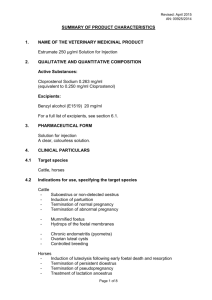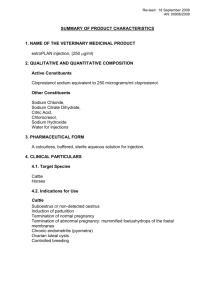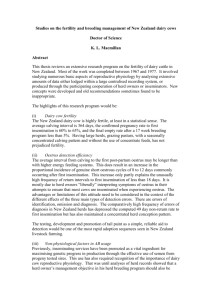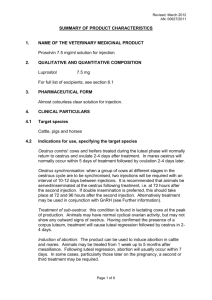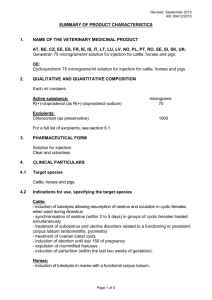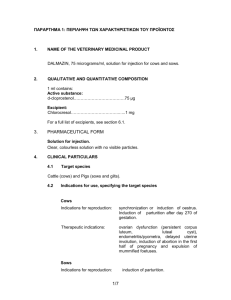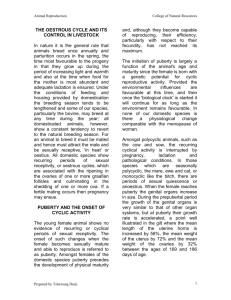Revised: February 2013 AN: 01561/2012 SUMMARY OF PRODUCT
advertisement
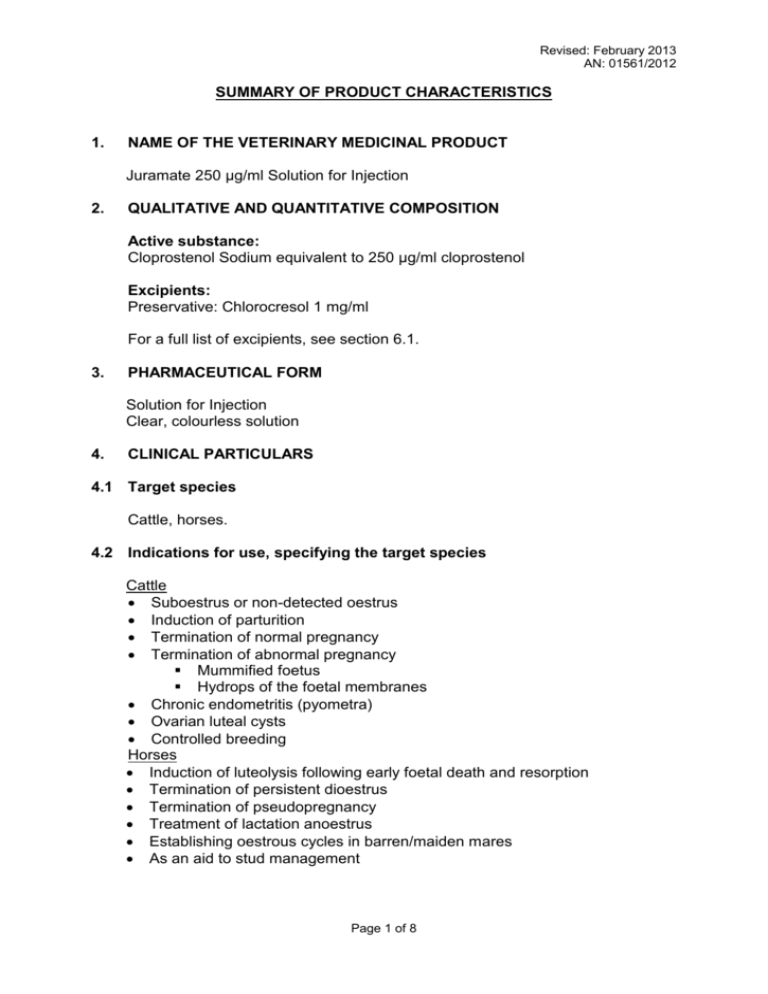
Revised: February 2013 AN: 01561/2012 SUMMARY OF PRODUCT CHARACTERISTICS 1. NAME OF THE VETERINARY MEDICINAL PRODUCT Juramate 250 µg/ml Solution for Injection 2. QUALITATIVE AND QUANTITATIVE COMPOSITION Active substance: Cloprostenol Sodium equivalent to 250 µg/ml cloprostenol Excipients: Preservative: Chlorocresol 1 mg/ml For a full list of excipients, see section 6.1. 3. PHARMACEUTICAL FORM Solution for Injection Clear, colourless solution 4. CLINICAL PARTICULARS 4.1 Target species Cattle, horses. 4.2 Indications for use, specifying the target species Cattle Suboestrus or non-detected oestrus Induction of parturition Termination of normal pregnancy Termination of abnormal pregnancy Mummified foetus Hydrops of the foetal membranes Chronic endometritis (pyometra) Ovarian luteal cysts Controlled breeding Horses Induction of luteolysis following early foetal death and resorption Termination of persistent dioestrus Termination of pseudopregnancy Treatment of lactation anoestrus Establishing oestrous cycles in barren/maiden mares As an aid to stud management Page 1 of 8 Revised: February 2013 AN: 01561/2012 4.3 Contraindications None 4.4 Special warnings for each target species Due to the possibility of post-injection bacterial infections, careful aseptic techniques should be employed. 4.5 Special precautions for use i. Special precautions for use in animals Not applicable. ii. Special precautions to be taken by the person administering the veterinary medicinal product to animals Prostaglandins of the F2 type can be absorbed through the skin and may cause bronchospasm or miscarriage. Care should be taken when handling the product to AVOID SELFINJECTION OR SKIN CONTACT. Women of child-bearing age, asthmatics and persons with bronchial or other respiratory problems should avoid contact with the product, and should wear disposable plastic gloves when administering the product. The possible incidence of bronchospasm with the product is unknown. Should shortness of breath result from accidental inhalation of injection, seek urgent medical advice and show the doctor this warning. Accidental spillage on the skin should be washed off immediately with soap and water. 4.6 Adverse reactions (frequency and seriousness) On rare occasions severe life-threatening local bacterial infections may occur associated with clostridial proliferation at the injection site. It is important to keep treated animals under observation and, if such infection occurs aggressive antibiotic therapy, particularly covering clostridial species, should be employed as a matter of urgency. Careful aseptic techniques should be employed to decrease the possibility of these infections. 4.7 Use during pregnancy, lactation or lay Do not administer to pregnant animals unless the objective is to terminate pregnancy. 4.8 Interaction with other medicinal products and other forms of interaction None known. Page 2 of 8 Revised: February 2013 AN: 01561/2012 4.9 Amounts to be administered and administration route Do not administer intravenously. CATTLE (Single or repeated 2mL doses (equivalent to 500 µg. of cloprostenol) by intramuscular injection). Therapeutic indications Sub-oestrus (or non detected oestrus) After diagnosing the presence of a corpus luteum – by rectal palpation – treat with the product and inseminate those animals showing heat. Those animals which do not show heat to be re-examined 11 days later and may receive a second injection and be bred at oestrus or at fixed times; once at 72-84 hours or twice at 72 and 96 hours. Induction of parturition Induces parturition in the period around normal term. Induction should take place as close to the predicted calving date as possible and not more than 10 days before. Induction should not be attempted before day 270 of gestation measured from the confirmed day of conception, except in pathological conditions. All treated animals must receive adequate supervision. In common with other methods of shortening the gestation period a higher than usual incidence of retention of the foetal membranes is to be expected. Termination of normal pregnancy Normal pregnancy can be terminated in cattle from one week after conception until the 150th day of gestation. Best results are obtained during the first 100 days. Treated animals should be kept under observation until expulsion of the foetus and placenta is complete. Termination of abnormal pregnancy Mummified foetus – induction of luteolysis at any stage of pregnancy will result in the expulsion of the mummified foetus from the uterus into the vagina from which manual removal may be necessary. Normal cyclical activity should then follow. Hydrops of the foetal membrane – Pathological accumulation of placental fluids can cause severe physiological complications and death. Surgical drainage is not usually successful in alleviating the condition. In such cases, a single dose may be used to induce parturition. Chronic endometritis (Pyometra) Treat with a single dose. In long-standing cases treatment may be repeated after 10-14 days. Ovarian luteal cysts Where cystic ovaries associated with persistent luteal tissue and absence of heat are diagnosed, the product has proved to be effective in correcting the condition and bringing about a return to cyclicity. Page 3 of 8 Revised: February 2013 AN: 01561/2012 Other indications: Controlled breeding Examples of programmes which have been used are: i) A single treatment of cattle with palpable evidence of a corpus luteum, followed by breeding on detection of the subsequent oestrus. ii) Detection of oestrus for 6 days, breeding those animals seen in heat; a single treatment is given to all non-served animals on the 6th day and these cattle are bred at subsequent oestrus. iii) Two injections 11 days apart, breeding at oestrus or at fixed times (see below). iv) As iii) above, but breeding any animals showing oestrus before the second injection. Thus the second dose is given only to those cattle not seen in oestrus during that time and is followed by breeding either on signs of oestrus or at fixed times (see below). Cattle which respond to a single prostaglandin injection will normally do so within 6 days of treatment. The response time after two injections is more rapid. Animals may be inseminated on detection of oestrus in any of the breeding programmes. However, fixed time insemination should only be used following the second of a two injection programme (i.e. examples iii) and iv)). In the latter case insemination should be performed either once at 72-84 hours or twice at 72 and 96 hours after the second injection, as preferred. Double ‘fixed-time’ insemination may give superior results to a single insemination. However, economic factors in the particular herd may outweigh such a benefit. For successful treatment, animals should be cycling normally. Rectal examination before treatment should avoid the disappointment of treating non-cycling (an-oestrus) or pregnant animals. Attention should be directed to the diet and condition of the treated animals. Sudden changes in feeding levels, in feed constituents and in housing, etc should be avoided around the time of the breeding programme, as should any other factor, such as regrouping, which could reasonably be expected to lead to stress. If artificial insemination is to be used, the quality of semen and insemination technique should be assured beforehand. A recommended guideline for use of the product in dairy cows would be as follows: After the first injection, inseminate any cows showing signs of heat. Animals that do not show signs of heat should be injected 11 days after the first injection and then inseminated 72-96 hours later. Control of the oestrous cycle is of value in:1) The dairy herd: Page 4 of 8 Revised: February 2013 AN: 01561/2012 a) b) c) 2) To control oestrus in the individual animal giving better control of the individual calving index and reducing the number of cows culled as barren. To control oestrus in groups of cows to promote management of the herd in groups of suitable size and facilitate the maintenance of a seasonal calving pattern. To permit the use of artificial insemination (AI) in dairy heifers. The beef herd: a) To facilitate the use of AI to obtain better progeny by use of high quality bulls. b) To enable the most effective use of available bulls where natural service is preferred. c) To permit better herd management at conception and calving. HORSES Ponies and donkeys: single dose of 0.5-1.0 ml (equivalent to 125-250 µg of cloprostenol) by intramuscular injection. Thoroughbreds, hunters and heavy horses: 1-2 mL (equivalent to 250-500 µg of cloprostenol) by intramuscular injection). Induction of luteolysis following early foetal death and resorption: about 8-10% of all mares which conceive lose the conceptus during the first 100 days of pregnancy. Persistence of luteal function in the ovary precludes an early return to oestrus. Termination of persistent dioestrus: non-pregnant mares frequently and spontaneously go to and out of periods of prolonged dioestrus. A very high proportion of mares in this category i.e. not cycling, are in prolonged dioestrus rather than anoestrus, particularly in the latter part of the breeding season. Termination of pseudopregnancy: some mares which are covered at normal oestrus and subsequently found to be empty (but not having lost or resorbed a conceptus) display clinical signs of pregnancy. These animals are said to be “pseudopregnant”. Treatment of lactation anoestrus: failure of lactating mares to cycle again for several months after exhibiting an early ‘foal heat’ can be avoided. Establishing oestrous cycles in barren/maiden mares: some of these animals will be found, on examination, to have a functional corpus luteum and are suffering from abnormal persistence of luteal function or are simply failing to exhibit normal oestrous behaviour (“silent heat”) while ovarian cyclicity continues. As an aid in stud management: mares may be brought into oestrus on a planning timing schedule (singly or in groups), to facilitate more efficient use and management of stallions during the breeding season. Page 5 of 8 Revised: February 2013 AN: 01561/2012 4.10 Overdose (symptoms, emergency procedures, antidotes), if necessary Cattle: At x5 to x10 overdose the most frequent side effect is increased rectal temperature. This is usually transient, however, and not detrimental to the animal. Limited salivation may also be observed in some animals. Horses: The most frequently observed side effects are sweating and decreased rectal temperatures. These are usually transient, however, and not detrimental to the animal. Other possible reactions are increased heart rate, increased respiratory rate, abdominal discomfort, locomotor incoordination and lying down. If these occur, they are likely to be seen within 15 minutes of injection and disappear within 1 hour. Mares usually continue to eat throughout. 4.11 Withdrawal period(s) Cattle should not be slaughtered for human consumption within 24 hours after administering the product. It is not necessary to discard milk from treated cattle. Do not administer to horses intended for human consumption. 5. PHARMACOLOGICAL PROPERTIES Pharmacotherapeutic group: ATCvet code: QG02AD90 5.1 Pharmacodynamic properties Cloprostenol is a synthetic prostaglandin analogue structurally related to Prostaglandin F2 (PGF2). As a potent luteolytic agency it causes functional and morphological regression of the corpus luteum (luteolysis) in cattle and horses followed by return to oestrus and normal ovulation. Note:There is a refractory period of four to five days after ovulation when cattle and horses are insensitive to the luteolytic effect of prostaglandins. Juramate has a good safety margin and does not impair fertility. No deleterious effects have been reported on the progeny conceived at the oestrus following treatment. 5.2 Pharmacokinetic particulars After its administration by injection, cloprostenol is metabolised to acid 9, 11, dihydroxy-15-ceto prost-5-enoic and 9,11, 15-trihydroxyprost-5-enoic which rapidly disappear from the blood, being excreted via the urine in 5-6 hours. Radiolabelled studies show blood levels between 0.0014 and 0.002 g per ml at 20 minutes – 2 hours after its administration. Subsequently, blood levels fall rapidly, having an apparent half life of 1-3 hours, falling below 0.00004 g/ml at Page 6 of 8 Revised: February 2013 AN: 01561/2012 8 hours. No significant concentrations are found at 24 hours in the liver, muscle, heart, kidneys, uterus, ovaries, skin, brain and fat, or in milk after 4 hours. 6. PHARMACEUTICAL PARTICULARS 6.1 List of excipients Chlorocresol Sodium Chloride Sodium Citrate Citric Acid Anhydrous Sodium Hydroxide (for pH adjustment) Water for Injections 6.2 Incompatibilities Strong acid/alkaline products 6.3 Shelf life Shelf-life of the veterinary medicinal product as packaged for sale: 3 years Shelf-life after first opening the immediate packaging: 28 days. 6.4. Special precautions for storage Following withdrawal of the first dose, use the product within 28 days. Protect from light. 6.5 Nature and composition of immediate packaging Cardboard box containing one clear glass (type I) vial of 20 ml, closed with a chlorobutyl rubber stopper and aluminium cap. 6.6 Special precautions for the disposal of unused veterinary medicinal product or waste materials derived from the use of such products Any unused veterinary medicinal product or waste materials derived from such veterinary medicinal products should be disposed of in accordance with local requirements. 7. MARKETING AUTHORISATION HOLDER Jurox (UK) Limited Microbial Developments Building Spring Lane North Malvern Link Worcestershire WR14 1BU UK Page 7 of 8 Revised: February 2013 AN: 01561/2012 8. MARKETING AUTHORISATION NUMBER Vm 25296/4001 9. DATE OF FIRST AUTHORISATION Date: 14 August 2008 10. DATE OF REVISION OF THE TEXT Date: February 2013 Approved: 07/03/13 Page 8 of 8

